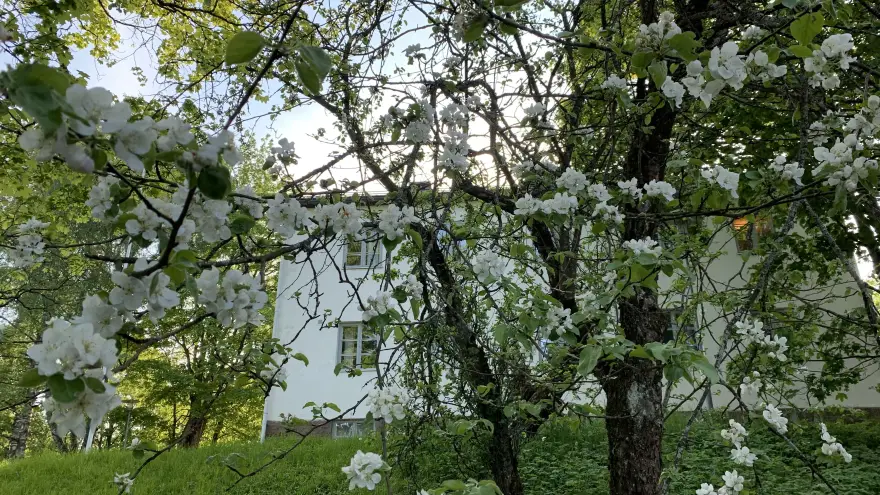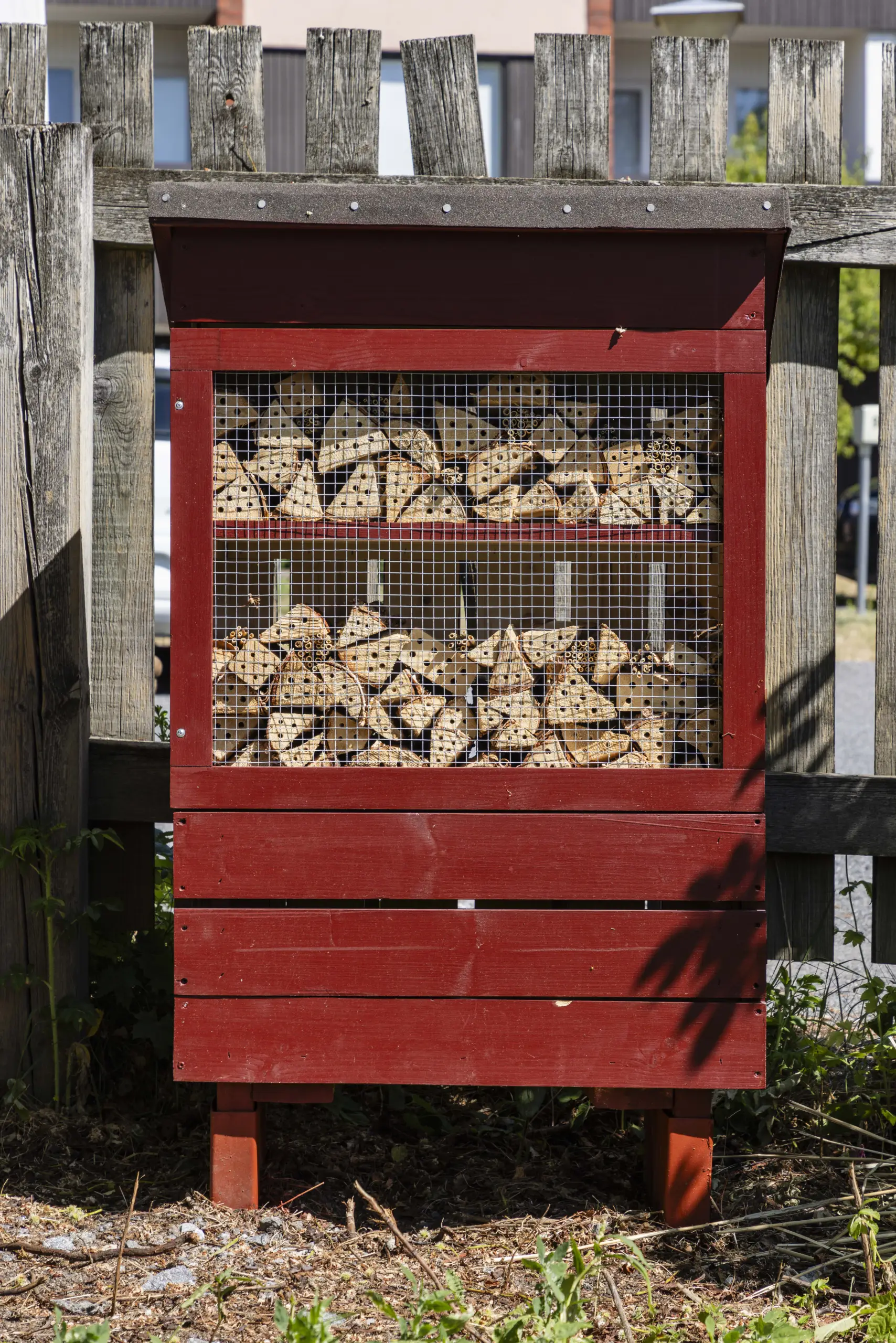Sustainable Buildings and Facilities in Municipal Cultural Services

Energy efficiency, renewable energy solutions, shared and multi-purpose spaces, recycling, and practices that preserve and enhance biodiversity.
Municipal cultural services typically operate in buildings owned by the municipality. As such, the responsibility for climate action and biodiversity measures related to the properties, facilities, and surrounding environments used by cultural services usually lies with the municipality—particularly with its facilities and property management departments. Cultural services can contribute to climate mitigation by implementing practices that save energy and improve space utilisation. They can also maintain outdoor areas that support biodiversity, such as meadows and nesting sites that are favourable to pollinators.
The examples in this article are drawn from the report Best Practices in the Environmental Work of Municipal Cultural Services (Kuntien kulttuuripalveluiden ympäristötyön hyvät käytännöt). The report offers a broad overview of good practices in Finnish libraries, arts and cultural institutions, cultural centres, basic education in the arts, and general cultural services.
Common Environmental Actions in Municipal Cultural Service Buildings and Facilities
- Shared use of spaces and rental arrangements
- Operating in premises that have been repurposed from their original use
- Utilising and activating otherwise vacant spaces
- Turning off or automating the power-down of devices and lighting
- Transitioning to energy-saving LED lighting
- Energy efficiency improvements carried out during major renovations by property owners
- Providing diverse recycling options in customer and staff areas
Good Practices
Energy Efficiency and Renewable Energy
Karkkila City Library • Energy Films on Windows
The facilities department of the City of Karkkila installed energy films on the skylights of Karkkila City Library. These films protect books from UV radiation and are also expected to improve the building’s thermal performance.
Kasarminkangas Museum Area • Heating System Upgrade and Energy Efficiency Measures
In the municipality of Rautjärvi, the buildings in the Kasarminkangas museum area have been restored to meet modern standards. The heating system has been upgraded from oil to an air-to-water heat pump hybrid. The museum building known as Komendantti is kept at a low base temperature during the winter season, and heating is also kept moderate during the summer.
Education Campus Siuntion Sydän • Renewable Energy Solutions in a New Building
The Siuntion Sydän education campus, completed in 2022, was designed with energy efficiency and environmental sustainability in mind. This included the selection of ventilation systems, automation of technical systems, and the choice of heating method. The campus is heated with geothermal energy and generates approximately 30% of its electricity through solar panels. The campus also houses, among others, the Siuntio Municipal Library.
Tampere Hall • Energy Efficiency and Renewable Energy Sources
As part of its long-term environmental work, the cultural and congress centre Tampere Hall has gradually transitioned to using renewable energy and improved its energy rating from E to C. The building is equipped with three solar power systems on its roof and also utilises local district cooling.
Various Cultural Centres and Venues • Energy Efficiency in Renovations
Major renovations provide a natural opportunity to implement energy efficiency measures. For example, in the city of Kokkola, cultural facilities have switched to more energy-efficient lighting in connection with renovations and refurbishments. Energy efficiency is also improved by adjusting indoor temperatures as needed. At Nurmes-talo in Nurmes, technical systems were upgraded and programmable lighting was installed during a major renovation between 2019 and 2021.
Energy Actions in the Theatre
Helsingin Kaupunginteatteri osallistui vuonna 2022 mukaan Helsingin kaupungin Kaupunkiympäristön toimialan energiaselvityshankkeeseen. Selvitys toteutettiin teatterin kiinteistössä alkuvuodesta 2023 ja sen tavoitteena oli etsiä toimenpiteitä energiatehokkuuden parantamiseksi. Raksystems Insinööritoimisto Oy:n (nyk. Sustera) toteuttamassa katselmuksessa esiteltiin teatterin LVI- ja sähköteknisten energian- ja vedenkäytön nykytila sekä mahdollisuuden pienentää kohteen lämmön, sähkön ja veden kulutusta ja kustannuksia. Johtopäätöksistä opittiin, että teatterin kiinteistöä hoidetaan jo optimaalisella tavalla, eikä olennaisia kiinteistöön tai sen hallintaan liittyviä toimenpiteitä energiatehokkuuden parantamiseksi löytynyt.
In 2022, Helsinki City Theatre joined an energy audit project led by the City of Helsinki’s Urban Environment Division. The audit was carried out in early 2023 and aimed to identify measures to improve energy efficiency in the theatre’s building. The review, conducted by Raksystems Insinööritoimisto Oy (now Sustera), assessed the current state of the building’s HVAC and electrical systems, as well as water and energy use, and explored ways to reduce consumption and costs. The findings showed that the building was already being managed optimally, and no major improvements were identified.
Nevertheless, the theatre pursued further energy-saving and self-sufficiency measures with the help of a municipal energy grant. In 2023, the theatre replaced all lighting fixtures on its main stage—previously based on inefficient halogen and discharge lamps—with LED spotlights. This change reduces both energy use and maintenance costs. The grant also supported the replacement of fluorescent lighting with LEDs in the set and costume workshops, and the installation of a rooftop solar power system. The solar plant was commissioned in 2024 and now produces approximately one percent of the theatre’s annual electricity consumption. That same year, the theatre also invested in additional electric vehicle charging stations.
Shared and Multi-Purpose Use of Spaces
Kerava Dance Institute • From Separate Offices to Multi-Use Spaces
Kerava Dance Institute has significantly improved the utilisation rate of its premises. With the help of project funding, the institute renovated a space that now functions as an office during the day and as a teaching space in the evenings. By using movable desks and other simple solutions, the result is a versatile, multi-purpose space. As a result of the renovation, the institute completely gave up its separate office and teaching spaces.
Cultural Space Näkkäri • A Shared Cultural Venue
Näkkäri, a shared cultural space designed for performing arts, serves students of basic arts education at the Salo Adult Education Center and children’s cultural events organized by public cultural services. Before being converted into a shared space, the venue was an underused auditorium. Its utilisation rate has since increased significantly, with only limited availability on weekends. Local associations in Salo can use the space free of charge, while external organisations and companies can rent it for a fee.
Multiple Libraries • Improving Space Utilisation
Libraries are improving the use of their spaces by changing their functions and related practices. For example, a former computer classroom at Pornainen Municipal Library was converted into a meeting room, increasing its usage. Pieksämäki City Library has extended opening hours, and its self-service libraries are also open on weekends. These extended hours allow more users and organisations to access the facilities, improving utilisation and enabling the city to reduce the number of other municipal properties.
Various Educational Institutions • Shared Use of School Facilities
Many art schools use school buildings to deliver instruction. For example, Huittinen Music Institute, which operates across nine municipalities, provides lessons at satellite locations within comprehensive school buildings. Even in its home municipality, the institute operates without dedicated art education facilities, instead sharing learning environments with schools or the music institute itself. Western Central Finland Music Institute and Keuruu Adult Education Centre also operate in school premises.
Waste Recycling
Kerava City Library • Enhancing Recycling Practices
Many libraries engage in comprehensive recycling of various waste streams. At Kerava City Library, special attention has been given to separate collection containers for items such as ink cartridges, waste toner containers, and batteries. Efforts have also been made to improve waste sorting in staff areas. In customer areas, sorting bins are available for public use.
Various Cultural Centres and Venues • Collection of Biowaste
Separate collection of biowaste helps conserve natural resources and supports the transformation to sustainability, as biowaste can be used to recover nutrients and produce renewable energy. For example, food waste is collected as biowaste at the children’s cultural centres Pessi and Toteemi in Vantaa, as well as at Nurmes-talo in Nurmes.
Vekarateatteri • On-Site Composting
Vekarateatteri in Kerava uses its own composting unit to process all food scraps. In addition to composting, the theatre sorts its waste into eco, mixed, plastic, and cardboard bins.

Biodiversity
Helsinki City Theatre • Flourishing Culture
The Flourishing Culture (Kukoistava kulttuuri) urban gardening initiative at Helsinki City Theatre offers the theatre staff the opportunity to engage in urban cultivation. The theatre’s courtyard features raised beds where edible plants and wildflowers are grown to support pollinators and other insects.
Raasepori Museum and Chappe • Bee Barn
As part of the exhibition Climate Art – Alternative Perspectives, a work titled Bibod (Bee Barn) was created in the courtyard of Raasepori Museum and Chappe. The piece was developed in a workshop led by Swedish visual artist Erik Sjöd, where participants built nesting sites for pollinators using natural materials. The installation now serves as a permanent habitat for pollinators. A handbook for building a bee barn is available from Chappe’s museum shop and online.
Tampere Hall • Urban Beehives
Four beehives are located on the roof of the cultural and congress centre Tampere Hall. The first hive was installed in 2018. The bees collect nectar within a two to three kilometre radius, including from nearby linden trees. The hives are maintained by beekeeper Teemu Aittamaa from Korpikuusikon Hunaja.
Various Museum Sites • Space for Native Species and Biodiversity
At the local heritage museum managed by the municipality of Vieremä, lawn mowing has been reduced to allow native plant species to grow freely around the buildings and grounds. At the Kasarminkangas museum area in Rautjärvi, landscape maintenance includes measures to preserve and enhance biodiversity.
Vekarateatteri • Promoting Biodiversity in the Theatre Grounds
At Vekarateatteri in Kerava, biodiversity is supported by leaving parts of the lawn unmown. The grounds also feature ten birdhouses and a deadwood fence. The original terracing of the yard has been restored, and new terraces have been built using cut stones. Vekarateatteri operates in Kulttuurikeskus Hyyppärä, a log villa built in 1908.
Ihan pihalla! – Experiences in Museum Gardens
The project Ihan pihalla!, carried out in 2021–2022, focused on enhancing the use and appeal of the outdoor areas at Lohja Museum and Johannes Lohilampi Museum. The project introduced new, visitor-oriented ways to engage with cultural heritage, raised awareness of the cultural environment, and created opportunities for leisure activities in the museum gardens. It also piloted new forms of self-guided heritage education and developed the outdoor areas as recreational spaces.
The diverse programme included raised-bed gardens, a themed nature evening, an apple tree pruning course, birdwatching, an environmental art exhibition, and a herb walk. Six beehives were also established, and the honey they produce is sold in the Lohja Museum shop.
The impact of the project was monitored using visitor counters in the courtyards and customer surveys, among other methods. According to the results, the project reached 14,000 visitors, and feedback indicated high levels of satisfaction. Many of the activities introduced during the project have continued as part of the museums’ regular operations. For example, there are now more events on offer, and the information boards erected during the project about the history of the area, its buildings, and its garden culture will remain permanently in the courtyards. The project was primarily funded by the Finnish Heritage Agency’s grant for innovative projects in professional museums.
Municipal Cultural Services
In Finland, municipal cultural services refer to activities through which a municipality promotes the creation, participation, accessibility, and use of culture and the arts. This includes arts and cultural education as well as the preservation of cultural heritage.
Environmental Work
An organisation’s goal-oriented and systematic efforts to achieve ecological sustainability. Environmental work may include actions to reduce greenhouse gas emissions or biodiversity loss.